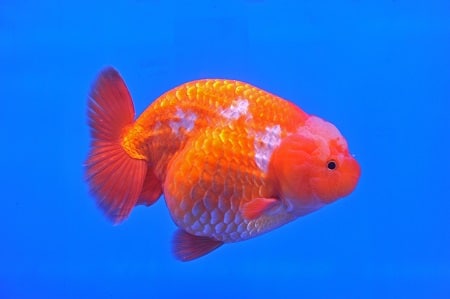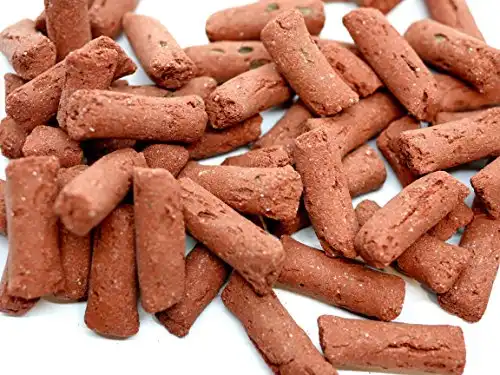Thank you for visiting! By the way… any links on this page that lead to products on Amazon and other stores/partners are affiliate links Aquarium Store Depot earns a commission if you make a purchase.
Considered the “King of Goldfish” by the Japanese, Ranchu goldfish are among the oldest and most popular fancy goldfish. They hold a special place in the minds of many goldfish enthusiasts, thanks to their unique appearance. An aquarium teeming with these beautiful fish is sure to enhance the aesthetic appeal of just about any place, be it your home or your office!
So, if you’re looking to keep fancy goldfish, you should consider Ranchu Goldfish. They are available in various shapes and colors to make your fish tank appear lavish and elegant. Keep reading to learn more about these incredible fancy goldfish, as we will provide all the necessary information on how to properly care for your King (or Queen).
A Brief Overview of Ranchu Goldfish
| Scientific Name | Carassius Auratus Auratus |
| Common Names | Maruko, Buffalo-head Goldfish, Korean Goldfish |
| Family | Cyprinidae |
| Origin | Japan |
| Diet | Omnivore |
| Care Level | Moderate |
| Activity | Moderately Active |
| Lifespan | 10 to 15 Years |
| Temperament | Peaceful |
| Tank Level | Medium |
| Minimum Tank Size | 20 Gallons |
| Temperature Range | 65°F to 72°F |
| Water Hardness | 4-20 dGH |
| pH Range | 6.5 to 7.5 |
| Filtration/Water Flow | Moderate |
| Water Type | Freshwater |
| Breeding | Egg-layer |
| Difficulty to Breed | Moderate |
| Compatibility | Compatible with Other Slow-Moving Fancy Goldfish |
| OK, for Planted Tanks? | With Caution |
Origins and Habitat
The story of Ranchu Goldfish (Carassius auratus) begins in ancient Japan, unlike other fancy goldfish that began in ancient China. They were developed from Chinese Lionhead Goldfish by skilled Japanese breeders. Today, modern day Ranchu Goldfish can be found almost anywhere in the world, not just in China or Japan.
Ranchu’s aren’t wild fish, so we must look at their ancestors to learn about their natural habitat.
Like any other goldfish, they descended from an old species of wild carp, known commonly as the Gibel Carp, Silver Prussian carp, or simply Prussian Carp.
These wild carp thrive in slow-moving, slightly cold waters of ponds, lakes, and rivers. Ranchus also prefer similar water conditions and share a lot of traits with Prussian Carp and other goldfish.
What Does Ranchu Goldfish Look like?

It’s quite easy to identify Ranchu Goldfish as they have a rather unusual head growth, an egg-shaped body with a deeper belly, and a horizontally spreading caudal (tail) fin. Looking from the top view, they look a lot like moving worms when swimming. That’s where the name “Ranchu” comes from (which literally means “dutch worm” in Japanense).
Another striking feature of the Ranchu goldfish species is that they don’t have any dorsal fin, much like their Lionhead counterpart. However, Ranchus come with arched backs, unlike the flat backs of Lionhead specimens. Initially bred for top view, they look just as impressive when viewed from the sides nowadays.
They are available in a wide variety of colors, ranging from red, white, orange, blue to bi-colors like red-and-white, black and red, black and white, etc. Their scales can be metallic, matte, or nacreous. So, a couple of differently-colored Ranchus will make your aquarium colorful and lively! Black ranchu goldfish are one of my personal favorites.
These fish are comparatively more delicate than other goldfish because of their unique anatomy. So, they are probably not the best option for beginner aquarists. Overall, the beautiful appearance and the unique swimming style of the Ranchu goldfish make them the perfect candidate for any goldfish aquarium.
Are They Easy to Take Care of?
Ranchu Goldfish are genetically weaker than other goldfish as they are highly inbred. They are pretty exquisite and not as hardy as other species. Their unique anatomy makes them prone to health issues. So, they aren’t easy to take care of and require special care. You must have some experience before handling this fish.
The rounded body and the lack of dorsal fin reduce the amount of control Ranchus have over their body when swimming. So, they can’t swim as efficiently as others. Swimming is more tiring for them as well, as you will often see them moving slowly and resting now and then to regain energy. Moreover, the wen or the head growth usually covers their eyes and makes it harder for them to see.
As a result, Ranchus aren’t good at competing for food. In a tank with fast swimmers and aggressive fish, they will be unable to feed and thrive. The Ranchu goldfish cannot tolerate pollution at all. They will be quick to pick up diseases if the water isn’t clean enough.
Thanks to their rounded body shape, they are highly vulnerable to swim bladder disease. Furthermore, the wen can easily get infected. If you don’t keep a Ranchu goldfish in a well-maintained fish tank with a high-quality aquarium filter, they won’t thrive. It doesn’t take much to stress them out and put them into shock. Their care requirements are much higher than others, so make sure to be extra careful and put more effort.
What Is their Eating Habits?
It’s easy to feed Ranchus as they are omnivorous. They like to eat whatever they find, so it’s up to you to decide which type of food you will provide them. A well-balanced diet comprised of high-quality frozen, fresh, and flake foods is considered the best for any breed of goldfish.
Brine shrimp, Daphnia, tubifex worms, blood worms, black worms, etc., are some of the most suitable foods for Ranchus. You should minimize the use of live foods as they often contain bacteria and parasites that can make them sick. Ranchus usually take longer to feed as they have poor vision due to their head growth. You will have to feed them several times a day but remember not to overfeed.
A favorite food staple is soaked pellets or freeze fried food supplemented with vita-chem. This is a great way to add much needed nutrients to common foods. Probiotics are also becoming more common place with food manufacturers with Companies like Cobalt leading the charge.
One of the best nutritional supplements you can use for freshwater fish. Works great with pellet and fried dried foods.
Can They Live Alone?
The Ranchu, like any other goldfish, can live a long life in solitude. This breed of fish doesn’t mind living alone as long as they get enough food and decent water quality. However, they are social animals, and they can benefit from social interaction. Ranchus love playing around with other fish as they enjoy companionship.
They love being social in groups. In fact, check out super-cute video of Ranchu goldfish playing football (As reported by the South China Morning Post) to see how fun they can be to have around.
They will be visibly happier if you keep them together with other tank mates that won’t compete with them or harass them. So, it’s better to introduce similar types of fish in a Ranchu aquarium if you want the best for them. They do great in an all goldfish tank full of other fancy goldfish varieties.
How Big Can They Grow? What Tank Size Is Right for Them?
Fancy fish like the Ranchu Goldfish are developed to impress you with their shapes, not their sizes. With that being said, the average length of adult Ranchus is around 5”. However, under the right water conditions, they can grow even larger, up to 8 inches!
Learning the size is important because it determines what the tank size that houses them should be. You must make sure to provide them enough room where they can swim freely. In general, the minimum requirement for housing one full-grown Ranchu is 20 gallons.
However, you should start with 20-30 gallons if you want to ensure maximum comfort for your prized fish. Increase the tank size by 10-gallons every time you bring a new fish into the tank. Larger tanks are recommended because that will provide more space for them to swim, and you won’t have to deal with water changes as frequently.
How Long Do They Live?
The Ranchu have a surprisingly long lifespan. This breed of Japanese goldfish can live for 10 to 15 years! If you keep them in an aquarium with suitable water conditions and ensure a proper diet plan, you can increase the lifespan to 18 years or even more!
Taking care of Ranchus will undoubtedly pay off. Even though these fish have low tolerance, they will stay healthy and active for a long time as long as you provide for them.
Additionally, you should keep them under constant monitoring. Look for any signs of diseases or discomfort. Perform water changes as often as required. If you notice any difference in their bodies, take action quickly to prevent them from suffering or dying.
Are They Aggressive?
The Ranchu Goldfish is anything but aggressive. They have an incredibly peaceful temperament, and they are rather friendly and cheerful. Their unique structure prevents them from being violent, anyway. For instance, they can’t swim all that fast and tire out pretty easily. They can’t see clearly with their eyes, often due to the growth in their heads. You won’t see them fighting other fish for food because they aren’t equipped to compete.
However, Ranchus do enjoy foraging for food. Make sure not to choose aggressive fishes as their tank mates if you don’t want your goldfish to struggle for survival and fail. They get along pretty well with other similarly morphed goldfish. You can feel free to house them together in an aquarium. Rest assured, they will not transform your tank into the Colosseum and fight each other to death!
How Much Do They Cost?
The price may also vary depending on factors like the size, source, age, etc. In general, you should be able to get your hands on one of them for 5 to 25 dollars from any local pet store or local breeders. However Japan’s “King of Goldfish” has garnered a lot of popularity over the decades with its fancy appearance. Ranchus are prized by many aquarists all over the world, and they are definitely in demand.
The most expensive Ranchus will be shipped directly from Japan or China. These are the most prized of all Ranchus and earn their moniker of “King of Goldfish. These types of Ranchus will easily commander prices of over $50 and can get much more expensive! Importing is how you obtain Ranchu Goldfish developed for competing in various Japanese shows. The video below by hendrink Nursalim shows a competition level Ranchu competing in Aquarama in 2011.
Competition Ranchu Goldfish tend to have more defining features, and their price can range from hundreds to thousands of dollars! You don’t need them unless you’re in the Ranchu Goldfish Enthusiasts category and planning to win one of those competitions. You will have to spend quite some money taking care of these types of goldfish, which you should consider.
No matter what type of fish you get, you must invest in creating and maintaining a proper diet plan for keeping them healthy. Rest assured, they are definitely worth the price.
Tank Requirement
If you’re a goldfish enthusiast, chances are you’ve already got a fancy goldfish aquarium. It might just be the perfect one for the king of goldfish from Japan! A Ranchu will flourish in a tank with slow-moving clean water, with suitable temperatures (65° – 72°). The recommended aquarium size for a single Ranchu is 20 to 30 gallons.
The pH range must be within 6.5 to 7.5, while the hardness range should be around 5 to 19 dGH. Make sure to keep the levels of ammonia, and nitrite close to zero. Nitrate should be maintained below 40 PPM.
Filtration and Water Quality
There should be a functioning water filtration system for these fish. Given the delicate nature of this fish, You should elect at minimum a quality hang on the back filter for smaller aquariums.
For larger fancy goldfish setups, you should consider an oversized canister filter to manage nitrates with a quality all-in-one biomedia like BioHome. Setting your filtration up like this ensure you have the most stable water quality to keep your Ranchus in excellent health.
Editor's Choice!
This is the best media you can buy for your aquarium. It does it all - removes ammonia, nitrite, and nitrates
Goldfish Tank Environment
For creating a comfortable and natural environment, you should add a sand or fine gravel substrate. Ensure it’s safe and doesn’t pose any choking hazard because your fish will regularly dig around that part as they like foraging for food.
Feel free to decorate your aquarium but refrain from using anything with sharp edges and protruding tips. If you are using artificial plants, consider silk plants. If you are using aquarium rocks, consider rocks without sharp edges or round ones. Driftwood should generally be avoided unless you are rounding out edges and ensuring there is plenty of open room to swim.
You can add a variety of plants to make the environment appear more natural. Due to their digging habit, live plants may not always be suitable. Some great plants to consider for fancy goldfish would include:
Make sure to anchor your plants to rocks instead of the substrate. The difficulty with plants is why many choose to go with artificial plants.
Tank Mates
You must be careful in choosing suitable tank mates for the Ranchu Goldfish. They are best paired with other fancy goldfish such as:
- Black Moor Goldfish
- Oranda Goldfish
- Pearlscale Goldfish
- Fantail Goldfish
- Ryukin Goldfish
Final Words
Ranchu goldfish stand out easily from other fish aided by their unique body. The wen on their head, combined with their round body, and arched backs make them look special. You will be impressed at how lovely they appear when swimming, thanks to the horizontally spreading double tail.
If you take good care of these fish, your aquarium will be rightly populated with one of the fanciest goldfish you can find on the market. They will stay with you for a long time and keep you entertained! Ranchus keep a goldfish tank lively and entertaining. Consider adding these beautiful creatures! Leave a comment below if you think that we should add more information on how to care for them in this blog post.
- About the Author
- Latest Posts
I’m thrilled that you found Aquarium Store Depot! Here you’ll find information on fish, aquariums, and all things aquatics related. I’m a hobbyist (being doing this since I was 11) and here to help other hobbyists thrive with their aquariums! I adhere to a high quality Editorial Process and Review products with real life field usage and practical analysis.








having trouble keeping ph steady. 40 gal. tank. live plants. two small ranchu. testing water daily. weekly water changes. thanks
Hi Elizabeth. Check out my article on how to lower pH here. It may help with solutions.